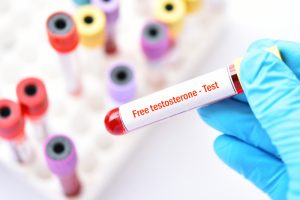By now, chances are, we’ve heard how important a role testosterone plays in men’s health–especially when it comes to increasing libido and boosting performance in bed.
And why not?
Testosterone levels tend to decline as men age after experiencing their absolute peak during early adulthood. After age 30, testosterone levels drop by as much as 1-2% per year, and this ratio is thought to increase with age.
Massive, sudden drop-offs in testosterone levels may be caused by Testosterone levels that tend to decrease with age. They peak by early adulthood and can drop by up to 1% per year beginning around age 40. Sometimes, these falls occur due to injuries, diseases, infections, or side effects arising from certain medications, chemotherapy, or radiation.
Testosterone is the primary “male” sex hormone associated with developing “masculine” characteristics. Still, the hormone is found in both men and women.
Most of the testosterone we have in our bodies binds to proteins like albumin and sex hormone-binding globulin (SHBG). Still, men and women have a small reserve of unbound free testosterone floating around the body.
And while a person can theoretically have average testosterone levels, they can just as much experience low free testosterone levels. This might invariably lead to symptoms such as erectile dysfunction, low libido, weight gain, hair loss, mood swings, and loss of bone and muscle mass, to name a few.
Aging is a hallmark cause of low T in the body. Still, low T can also arise due to testicular damage, obesity, diabetes, thyroid disorders, or side effects from medication.
Free Testosterone 101
Most of us would be familiar with testosterone. Still, not all might know that we have what is called “bound testosterone” and “free testosterone.” Testosterone generally binds to one of two proteins, albumin, and SHBG.
However, a smaller percentage running around 2-5% of your total testosterone levels is unattached and known as “free” testosterone. Like testosterone bound to albumin, free testosterone is more easily used by the body than others. It is known as the amount of bioavailable testosterone in the body.
Total testosterone levels are measured of bound and free testosterone in the bloodstream.
Testosterone plays a key role in libido, facial hair and body hair growth, erections, sperm production, mood regulation, keeping muscles and bones dense, and producing red blood cells.
Testosterone: where does it originate from?
Testosterone production is a complex process. It starts with the hypothalamus releasing gonadotropin-releasing hormone, or GnRH, which then tells the pituitary gland to introduce luteinizing hormones (LH) into the blood. Then, once LH arrives in the testicles, it stimulates Leydig cells in the testes, which are in charge of producing testosterone in men.
On the other hand, in females, the theca cells in the ovaries create testosterone.
As testosterone concentrations arise in the bloodstream, the pituitary gland and hypothalamus are motioned to inhibit testosterone production. While it may be a rather complicated process, this general process flow is how the body regulates hormone levels.
Why test for free testosterone?
More and more men are becoming worried about their testosterone levels, especially as they age.
Aging is a surefire factor that causes a decline in testosterone concentrations over time. As early as age 30, levels may start to drop at a rate of 1-2% per year and then degrade faster after age 80 and beyond.
Low testosterone in itself isn’t exactly a massive problem. The problem is when individuals manifest symptoms combined with their low testosterone levels, implying deficient testosterone concentrations. As much as 12% of men may have a testosterone deficiency, and this number increases–by age 80, nearly half of men this age bracket and above may experience low T.
Consult your doctor if you suspect you are experiencing low testosterone. You may be asked to take a series of tests to check both your total serum testosterone and free testosterone. Free T declines faster than total T. Other men may experience low free testosterone but otherwise normal total levels. Test for both types of testosterone so you can conclusively determine the full picture of your situation.
Free testosterone and its relationship to health
 Your testosterone levels are at their highest during the mornings, and concentrations fluctuate all day round. In general, testing for low T may need several tests between 8 to 10 in the morning, ideally to determine whether you have low T.
Your testosterone levels are at their highest during the mornings, and concentrations fluctuate all day round. In general, testing for low T may need several tests between 8 to 10 in the morning, ideally to determine whether you have low T.
Medical conditions that may lead to low T include being overweight/obese, metabolic diseases such as hypertension, diabetes, and high cholesterol, testicular/reproductive damage, autoimmune diseases, thyroid and pituitary gland dysfunctions, infections, and side effects from recreational drug use/antidepressant use.
Treating such underlying health conditions may lead to improved, more balanced testosterone concentrations in the bloodstream.
Should your testosterone measurements fall under the abnormal spectrum of testosterone levels, your doctor might ask you to undergo further tests on your LH (luteinizing hormone), FSH, or DHEA-S (dehydroepiandrosterone sulfate).
What to do in case your free T levels are low
Regardless of your total testosterone concentrations, you might still have low free T levels, which may lead to symptoms of low T like reduced sex drive, erectile dysfunction, tiredness and fatigue, and loss of muscle and bone mass.
Talk to your doctor if you suspect your free T levels are low and if any symptoms are manifesting.
Is it possible to have too much testosterone?
Testosterone levels need to be balanced with the rest of the hormones. Too little may lead to a low T diagnosis. Too much might cause side effects like acne breakouts, increased prostate cancer risk, gynecomastia, mood swings, hypertension, high cholesterol, and shrunken testicles.
Tumors in the testicles or adrenal glands may also cause an oversupply of high testosterone in men.
What to do in case you suspect you have low free T levels
Quite frankly, it is a fact of life that older men will experience a decline in their T levels compared to their younger years. And it’s not the number alone that matters–it’s whether your low testosterone concentrations lead to other health conditions. Consult your doctor, get a physical exam, and determine whether blood tests are required. Your primary health care provider will be in the best position to provide you the right response.



